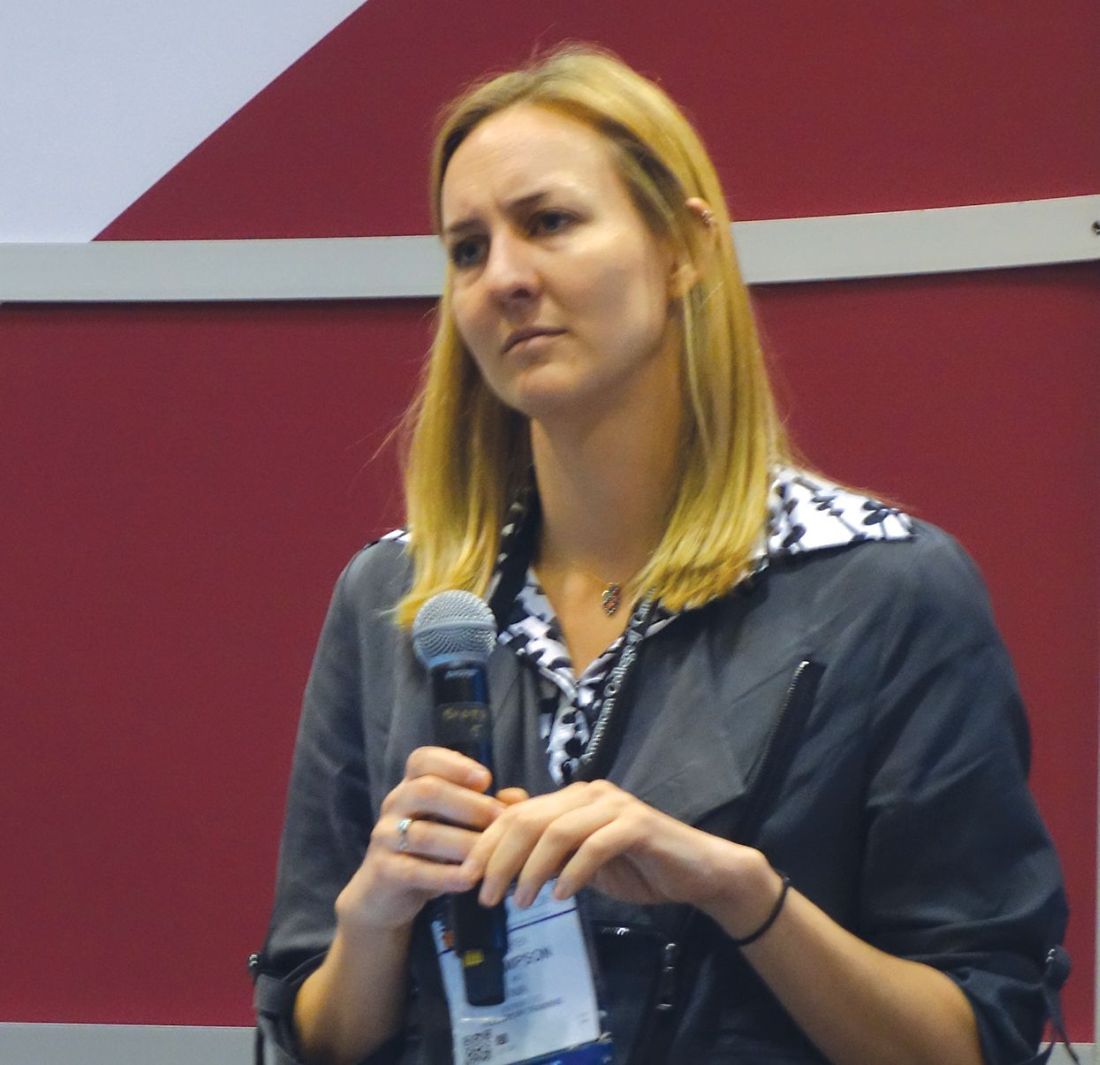User login
ORLANDO – More than one-third of patients with treatment-resistant hypertension in U.S. cardiology practices are eligible for preferential consideration of spironolactone as their fourth-line agent in accord with the practice-changing findings of the PATHWAY-2 trial, Lauren Thompson, MD, said at the annual meeting of the American College of Cardiology.
She presented a study that harnessed the ACC’s National Cardiovascular Data Registry PINNACLE Registry – the largest observational outpatient cardiovascular registry in the world – to assess the potential impact of PATHWAY-2 on the management of treatment-resistant hypertension (TRH) in U.S. cardiology practices. And as she discovered, the potential implications for daily practice are huge.
Dr. Thompson, a cardiology fellow at the University of Colorado, Denver, identified 19,044 patients in the PINNACLE registry for 2013-2014 with TRH, defined as uncontrolled blood pressure despite use of drugs from three antihypertensive classes. Of these patients, 37% met the PATHWAY-2 enrollment criteria by virtue of already being on an ACE inhibitor or angiotensin receptor blocker, a calcium channel blocker, and a thiazide diuretic, but not spironolactone. This is the large subgroup which, on the basis of PATHWAY-2, should receive serious consideration of spironolactone as the fourth drug.
The most widely prescribed antihypertensive agents in PINNACLE registry patients with TRH were beta-blockers, in 87%; ACE inhibitors, in 72%; calcium channel blockers, in 71%; and thiazide diuretics, in 69%. Of note, 27% of patients with TRH were already on spironolactone.
Audience discussion centered around the uncertainties regarding treatment adherence in patients labeled as having TRH.
“I think sometimes clinicians are afraid to prescribe spironolactone in patients that they think might be nonadherent,” one cardiologist observed.
Dr. Thompson noted that it’s not possible to look at prescription-filling rates in the PINNACLE registry.
“Unfortunately, we can’t exclude white coat hypertension or nonadherence as reasons why patients in PINNACLE end up on multiple antihypertensive medication classes. We can see that a prescription was written, but we have no way to know if it was actually filled or not,” she observed.
Also, since patients in cardiology clinics typically have multiple cardiovascular comorbidities, it’s quite possible that patients with TRH who are on a beta-blocker, for example, might not have received that drug for blood pressure control.
Dr. Thompson’s study was supported by the ACC’s National Cardiovascular Disease Registry. She reported having no financial conflicts of interest.
Source: Thompson L. ACC 18. Abstract 1324M-09.
ORLANDO – More than one-third of patients with treatment-resistant hypertension in U.S. cardiology practices are eligible for preferential consideration of spironolactone as their fourth-line agent in accord with the practice-changing findings of the PATHWAY-2 trial, Lauren Thompson, MD, said at the annual meeting of the American College of Cardiology.
She presented a study that harnessed the ACC’s National Cardiovascular Data Registry PINNACLE Registry – the largest observational outpatient cardiovascular registry in the world – to assess the potential impact of PATHWAY-2 on the management of treatment-resistant hypertension (TRH) in U.S. cardiology practices. And as she discovered, the potential implications for daily practice are huge.
Dr. Thompson, a cardiology fellow at the University of Colorado, Denver, identified 19,044 patients in the PINNACLE registry for 2013-2014 with TRH, defined as uncontrolled blood pressure despite use of drugs from three antihypertensive classes. Of these patients, 37% met the PATHWAY-2 enrollment criteria by virtue of already being on an ACE inhibitor or angiotensin receptor blocker, a calcium channel blocker, and a thiazide diuretic, but not spironolactone. This is the large subgroup which, on the basis of PATHWAY-2, should receive serious consideration of spironolactone as the fourth drug.
The most widely prescribed antihypertensive agents in PINNACLE registry patients with TRH were beta-blockers, in 87%; ACE inhibitors, in 72%; calcium channel blockers, in 71%; and thiazide diuretics, in 69%. Of note, 27% of patients with TRH were already on spironolactone.
Audience discussion centered around the uncertainties regarding treatment adherence in patients labeled as having TRH.
“I think sometimes clinicians are afraid to prescribe spironolactone in patients that they think might be nonadherent,” one cardiologist observed.
Dr. Thompson noted that it’s not possible to look at prescription-filling rates in the PINNACLE registry.
“Unfortunately, we can’t exclude white coat hypertension or nonadherence as reasons why patients in PINNACLE end up on multiple antihypertensive medication classes. We can see that a prescription was written, but we have no way to know if it was actually filled or not,” she observed.
Also, since patients in cardiology clinics typically have multiple cardiovascular comorbidities, it’s quite possible that patients with TRH who are on a beta-blocker, for example, might not have received that drug for blood pressure control.
Dr. Thompson’s study was supported by the ACC’s National Cardiovascular Disease Registry. She reported having no financial conflicts of interest.
Source: Thompson L. ACC 18. Abstract 1324M-09.
ORLANDO – More than one-third of patients with treatment-resistant hypertension in U.S. cardiology practices are eligible for preferential consideration of spironolactone as their fourth-line agent in accord with the practice-changing findings of the PATHWAY-2 trial, Lauren Thompson, MD, said at the annual meeting of the American College of Cardiology.
She presented a study that harnessed the ACC’s National Cardiovascular Data Registry PINNACLE Registry – the largest observational outpatient cardiovascular registry in the world – to assess the potential impact of PATHWAY-2 on the management of treatment-resistant hypertension (TRH) in U.S. cardiology practices. And as she discovered, the potential implications for daily practice are huge.
Dr. Thompson, a cardiology fellow at the University of Colorado, Denver, identified 19,044 patients in the PINNACLE registry for 2013-2014 with TRH, defined as uncontrolled blood pressure despite use of drugs from three antihypertensive classes. Of these patients, 37% met the PATHWAY-2 enrollment criteria by virtue of already being on an ACE inhibitor or angiotensin receptor blocker, a calcium channel blocker, and a thiazide diuretic, but not spironolactone. This is the large subgroup which, on the basis of PATHWAY-2, should receive serious consideration of spironolactone as the fourth drug.
The most widely prescribed antihypertensive agents in PINNACLE registry patients with TRH were beta-blockers, in 87%; ACE inhibitors, in 72%; calcium channel blockers, in 71%; and thiazide diuretics, in 69%. Of note, 27% of patients with TRH were already on spironolactone.
Audience discussion centered around the uncertainties regarding treatment adherence in patients labeled as having TRH.
“I think sometimes clinicians are afraid to prescribe spironolactone in patients that they think might be nonadherent,” one cardiologist observed.
Dr. Thompson noted that it’s not possible to look at prescription-filling rates in the PINNACLE registry.
“Unfortunately, we can’t exclude white coat hypertension or nonadherence as reasons why patients in PINNACLE end up on multiple antihypertensive medication classes. We can see that a prescription was written, but we have no way to know if it was actually filled or not,” she observed.
Also, since patients in cardiology clinics typically have multiple cardiovascular comorbidities, it’s quite possible that patients with TRH who are on a beta-blocker, for example, might not have received that drug for blood pressure control.
Dr. Thompson’s study was supported by the ACC’s National Cardiovascular Disease Registry. She reported having no financial conflicts of interest.
Source: Thompson L. ACC 18. Abstract 1324M-09.
REPORTING FROM ACC 18
Key clinical point:
Major finding: Thirty-seven percent of patients with treatment-resistant hypertension in U.S. cardiology practices could benefit from preferential consideration of spironolactone as their fourth-line antihypertensive agent.
Study details: This retrospective study included more than 19,000 patients with treatment-resistant hypertension in U.S. cardiology practices.
Disclosures: The presenter reported having no financial conflicts regarding her study, supported by the ACC’s National Cardiovascular Data Registry.
Source: Thompson L. ACC 18. Abstract 1324M-09.

